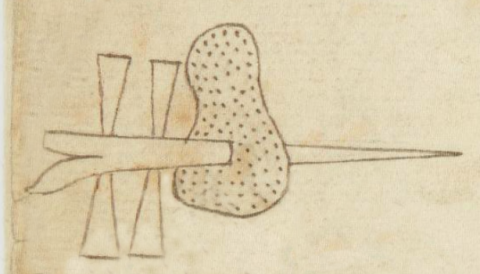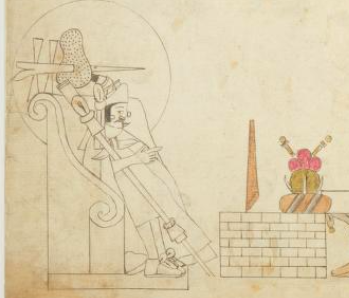Tizocicatl (Azca26)
This black and white drawing of the compound glyph for the personal name Tizocicatl (also known as Tizocic and simply as Tizoc) shows a keyhole shape filled with dots. These dots represent chalk (tizatl), providing the start to the name, Tiz-. The bone that penetrates this shape is like a needle used in sewing (zozo) and it makes the chalk look like a piece of fabric (zotl) that is being sewn with the bone needle. Thus, one or both of these elements provide the -zo- in the middle of the name. If the name originally included the -cica (or -tzica) ending, which sometimes got shortened to -cic, then perhaps that part is also represented by the sewing, which can result in things being fastened together (tzicatica). The final group of objects worth mentioning are the two thorns above and the two below the bone needle. These seem to be a reference to self-sacrifice in the way of bloodletting. An article in Arqueología Mexicana (2016) states that the name Tizocic means “He Who Makes Sacrifices.”
Stephanie Wood
Since this name is not glossed, we would normally call this an example of iconography, but given that the manuscript is arranged in order of the succession of leaders in Mexico Tenochtitlan, and this leader follows his brother Axayacatl, we feel certain enough that the name here is Tizocicatl (or Tizocic).
Stephanie Wood
post-1550, possibly from the early seventeenth century.
Jeff Haskett-Wood
gobernadores, imperio, tiza, coser, hueso, huesos

Tizocicatl, seventh ruler of Mexico Tenochtitlan, https://nahuatl.wired-humanities.org/content/tizocicatl
tiza(tl), chalk or white wash, https://nahuatl.wired-humanities.org/content/tizatl
tzicatica, fastening or sticking things together, https://nahuatl.wired-humanities.org/content/tzicatica
zozo, to string things together, sew, https://nahuatl.wired-humanities.org/content/zozo
zo(tl), a piece of cloth, https://nahuatl.wired-humanities.org/content/zotl
The Codex Azcatitlan is also known as the Histoire mexicaine, [Manuscrit] Mexicain 59–64. It is housed in the Bibliothèque Nationale de France, and hosted on line by the World Digital Library and the Library of Congress, which is “unaware of any copyright or other restrictions in the World Digital Library Collection.”
https://www.loc.gov/resource/gdcwdl.wdl_15280/?sp=26&st=image
The Library of Congress is “unaware of any copyright or other restrictions in the World Digital Library Collection.” But please cite Bibliothèque Nationale de France and this Visual Lexicon of Aztec Hieroglyphs.




